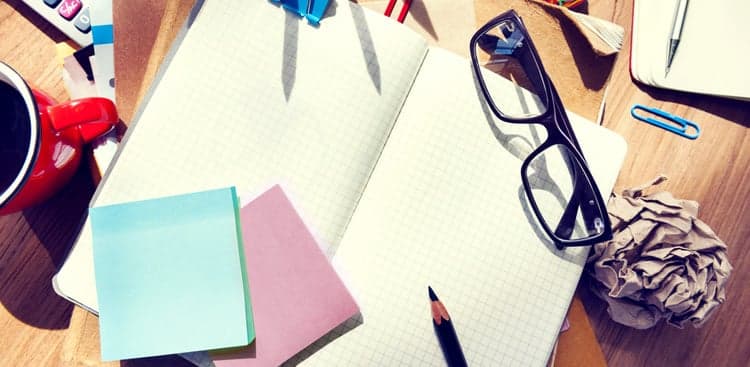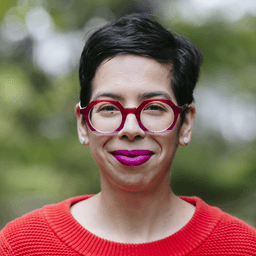A blank page can be an intimidating thing.
Writers, artists, and creators of all kinds struggle with it. Like any project, the beginning is often the most difficult part: We can’t get started, deadline or no. With creative endeavors in particular, we sometimes hide behind the excuse that we’re “waiting for inspiration.”
But anyone who has had an “a-ha!” moment in the shower knows that inspiration comes at all times: It’s not something you need to wait around for. (Which is why you should keep a spark file to capture those sporadic and delightfully unexpected waves of brilliance when they do come.) By the time you sit down to write, draw, or create whatever it is you’re working toward, the ideas are likely already there.
At that point, creating becomes a matter of discipline. The real challenge to conquering a blank canvas is having the will to diligently concentrate, focus, and commit to physically sitting down to create a thing. Behind the myth of the genius artist is the simple truth that all good writers and artists have some sort of ritual to produce the way they do.
Below are seven ideas for getting over the blank canvas phase. Many of these tips were initially devised for writers, but they can be easily modified for illustrators, designers, or anyone else starting something from scratch, too.
1. Choose a Tool That Inspires You
You know that feeling of staring at a blank Microsoft Word document, just watching the cursor slowly blink? If that image fills you with dread, it’s time to find a new tool. The right set of working tools can make the creative process that much easier—when you really like your toolkit, you look forward to creating even more.
Some suggestions to test: For digital work, Ulysses is a simple writing tool that allows you to set small, incremental goals (based on things like word count and time spent in-app) to get you going. FiftyThree’s Paper app is also an excellent tool for sketching and illustrating. The analog counterpart to these is a lovely Moleskine notebook and pens that make your work feel lavish and fun.
2. Start Early
Little-known fact: You have more willpower early in the day (before decision fatigue has a chance to set in). That means it’s easier to focus on the important things before life’s distractions take over.
There are many writers who have found early morning hours to be their most productive: Haruki Murakami, one of the most prolific writers of our time, starts his daily writing at 4 AM. Toni Morrison? 5 AM. While the wee hours of the morning might not be your natural productivity zone, it’s worth dedicating some uninterrupted early time to your craft and creative project—“early” can be relative, depending on your zone.
3. Pick a Goal or Focus for the Session
Pick a single, achievable outcome to focus on. This could be an intro paragraph or a whole chapter; a rough sketch or a detailed illustration; a single screen design or an entire user flow.
You should be going for depth, not breadth, here, and should be careful not to bite off more than you can chew. Focus your idea, and follow-through will become more manageable. If inspiration doesn’t hit one day, pull from your spark file and pick a gem from the past to work from.
You can also try focusing your session with a time constraint. Commit to just five minutes of creative time, no matter what. Within five minutes’ time, you’ll find you either want to keep going or scrap your work. Either outcome is productive. It is much easier to edit and improve an existing piece of work than to start over from square one. Five minutes up, and you’ve already done the hard part.
4. Do Things Backward to Get the Juices Flowing
This tip comes from a creative writing class I took in college: Write the first five things that come to your mind every morning—with your non-dominant hand. You’ll be surprised at the range of thoughts, images, and ideas that come out of this exercise. You may or may not turn those images into something more substantial; the more important part is to warm up those creative muscles and get something down on paper.
You can get a similar effect by switching up your medium. If you’re a writer, try a sketching session. Designer? Try writing instead. See what comes out of it. No judgement, just exploration.
5. Observe and Record to Get Something—Anything—on the Page
Watch a conversation unfold in real-time and take note. Observe the world around you and record what you’re seeing and experiencing. Or, copy something that already exists to get started—write someone else’s words or wireframe the work of a designer you admire, and then edit and tweak until you’re warmed up for your own piece.
Sometimes just the act of writing or sketching itself can help warm you up, even if it’s not your own work. (Hunter Thompson famously typed out The Great Gatsby and A Farewell to Arms as a way to learn about different writing styles.)
6. Leave a Sentence Unfinished
This tip is less to help you get over your creative block today, and more to help you avoid it tomorrow: When you wrap up for the day, leave your work in a good place, but slightly unfinished before shutting down. That way, you’ll have a place to pick up tomorrow—without once more facing the anxiety of a blank page.
Ernest Hemingway would regularly stop writing mid-sentence, and leave just enough to pick right up the next day. If it worked for him, why not you?
7. If All Else Fails, Do Nothing
Here’s a pro tip from the great writer Raymond Chandler on his writing ritual:
The important thing is that there should be a space of time, say four hours a day at least, when a professional writer doesn’t do anything else but write. He doesn’t have to write, and if he doesn’t feel like it, he shouldn’t try. He can look out of the window or stand on his head or writhe on the floor. But he is not to do any other positive thing, not read, write letters, glance at magazines, or write checks. Write or nothing.
If you’re completely stuck on your creative project, don’t work on it, but take Chandler’s advice and don’t allow yourself to do anything else, either. Don’t ruin the time spent not creating by making it about consuming.
Leave that open to inspiration instead. You’ll have something for tomorrow. Good luck!

